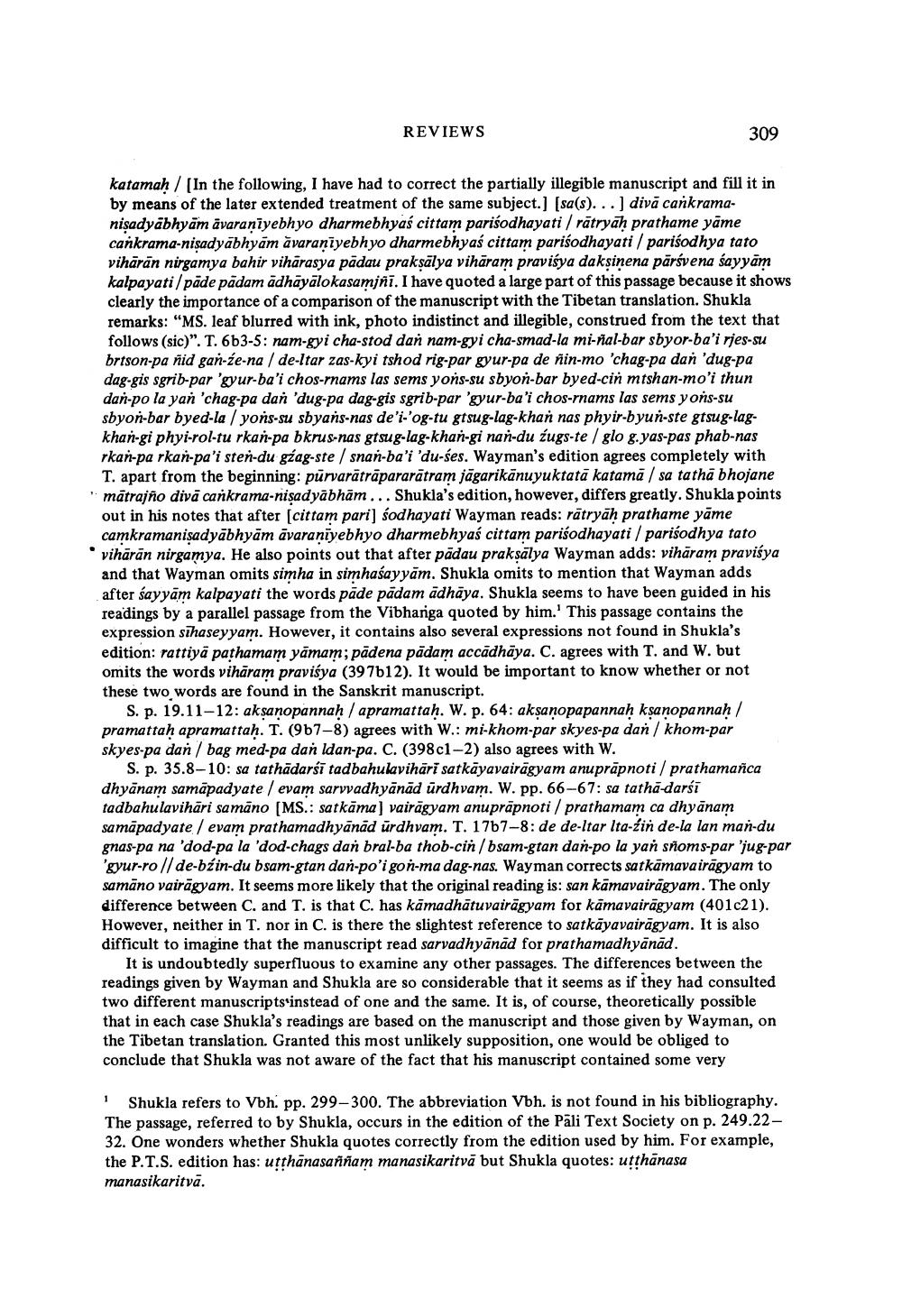________________
REVIEWS
309
katamah / [In the following, I have had to correct the partially illegible manuscript and fill it in by means of the later extended treatment of the same subject.] (sa(s)... ) divā cankramanişadyabhyām āvaranīyebhyo dharmebhyas cittam parisodhayati / rātryān prathame yāme cankrama-nisadyābhyām āvaranīyebhyo dharmebhyaś cittam parisodhayati / parisodhya tato vihārān nirgamya bahir vihārasya padau praksālya vihāram praviśya daksinena pārśvena sayyām kalpayati/pāde pādam adhāyālokasamini. I have quoted a large part of this passage because it shows clearly the importance of a comparison of the manuscript with the Tibetan translation. Shukla remarks: "MS. leaf blurred with ink, photo indistinct and illegible, construed from the text that follows (sic)". T. 663-5: nam-gyi cha-stod dan nam-gyi cha-smad-la mi-nal-bar sbyor-ba'i rjes-su brtson-pa ñid gań-ze-na / de-Itar zas-kyi tshod rig-par gyur-pa de nin-mo 'chag-pa dan 'dug-pa dag-gis sgrib-par 'gyur-ba'i chos-rnams las sems yońs-su sbyon-bar byed-cin mtshan-mo'i thun dan-po la yan 'chag-pa dan 'dug-pa dag-gis sgrib-par 'gyur-ba'i chos-rnams las sems yońs-su sbyon-bar byed-la / yońs-su sbyańs-nas de'i-'og-tu gtsug-lag-khań nas phyir-byun-ste gtsug-lagkhan-gi phyi-rol-tu rkan-pa bkrus-nas gtsug-lag-khan-gi nan-du zugs-te / glo g.yas-pas phab-nas rkan-pa rkan-pa'i sten-du gzag-ste / snan-ba'i 'du-ses. Wayman's edition agrees completely with
T. apart from the beginning: pūrvarātrāpararātram jāgarikānuyuktatā katamā / sa tatha bhojane "matrajño divā cankrama-nisadyābhām... Shukla's edition, however, differs greatly. Shukla points out in his notes that after [cittam pari) sodhayati Wayman reads: rätryāh prathame yāme camkramanisadyābhyām āvaraniyebhyo dharmebhyas cittam parisodhayati / parisodhya tato vihārān nirgamya. He also points out that after padau praksālya Wayman adds: vihāram pravisya and that Wayman omits simha in simhasayyām. Shukla omits to mention that Wayman adds after sayyām kalpayati the words pāde pādam adhāya. Shukla seems to have been guided in his readings by a parallel passage from the Vibhariga quoted by him.' This passage contains the expression sīhaseyyam. However, it contains also several expressions not found in Shukla's edition: rattiyā pathamam yāmam; pädena pādam accădhāya. C. agrees with T. and W. but omits the words vihāram praviấya (397b12). It would be important to know whether or not these two words are found in the Sanskrit manuscript.
S. p. 19.11-12: aksanopannah / apramattah. W. p. 64: aksanopapannaḥ ksanopannah / pramattaḥ apramattaḥ. T. (9b7-8) agrees with W.: mi-khom-par skyes-pa dan/khom-par skyes-pa dan / bag med-pa dan ldan-pa. C. (398c1-2) also agrees with W.
S. p. 35.8-10: sa tathādarśī tadbahulavihāri satkāyavairāgyam anuprāpnoti/prathamanca dhyānam samāpadyate / evam sarvvadhyānād urdhvam. W. pp. 66-67: sa tathā-darsi tadbahulavihāri samano (MS.: satkāma) vairāgyam anuprāpnoti/prathamam ca dhyānam samāpadyate / evam prathamadhyānad ürdhvam. T. 1767-8: de de-ltar Ita-zin de la lan man-du gnas-pa na 'dod-pa la 'dod-chags dan bral-ba thob-cin/bsam-gtan dan-po la yan snoms-par 'jug-par 'gyur-ro // de-bzin-du bsam-gtan dan-po'i gon-ma dag-nas. Wayman corrects satkāmavairāgyam to samāno vairāgyam. It seems more likely that the original reading is: san kāmavairāgyam. The only difference between C. and T. is that c. has kāmadhātuvairāgyam for kämavairāgyam (401c21). However, neither in T. nor in C. is there the slightest reference to satkāyavairāgyam. It is also difficult to imagine that the manuscript read sarvadhyānād for prathamadhyānād.
It is undoubtedly superfluous to examine any other passages. The differences between the readings given by Wayman and Shukla are so considerable that it seems as if they had consulted two different manuscripts instead of one and the same. It is, of course, theoretically possible that in each case Shukla's readings are based on the manuscript and those given by Wayman, on the Tibetan translation. Granted this most unlikely supposition, one would be obliged to conclude that Shukla was not aware of the fact that his manuscript contained some very
Shukla refers to Vbh. pp. 299-300. The abbreviation Vbh. is not found in his bibliography. The passage, referred to by Shukla, occurs in the edition of the Pali Text Society on p. 249.2232. One wonders whether Shukla quotes correctly from the edition used by him. For example, the P.T.S. edition has: utthānasaññam manasikaritvā but Shukla quotes: utthānasa manasikaritva.




